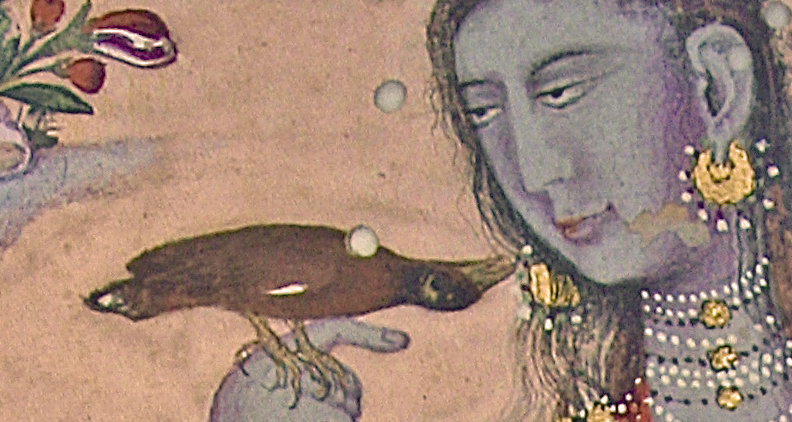Friends called my attention to this remarkable painting Yogini with Mynah (Freer/Sackler, 1603/04, opaque watercolor and gold on paper, India Karnataka, Islamic court of Bijapur), and it prompted me to gaze at it and scrutinize it.
The arbitrary scale in the landscape, like the overscaled plants in the middle ground, is conventional enough in a non-European work like this one; the oddity is apparent only when viewed with the perspectival perception ingrained in the Western tradition. The detail that I find befuddling is the bird, perched on the woman’s right hand, which turns the head completely upside down, an anatomically well-nigh impossible position. With its beak close to the mouth of the woman, the artist, we can be certain, designed it to draw the viewer’s attention to focus on the relationship between the Yogini and the bird, and we are forced to ponder on it.
Reading a picture is a risky business. Since the mynah, like the parrot, is a bird that “talks,” one may be tempted to to understand that the bird is conversing with the yogini, or, since the woman’s mouth is closed she may be only listening to what the bird is saying. One interpretation, mistakenly speaks of “the lady whispering to her talking bird” (http://www.indianart.ru/eng/of_the_deccan/7.php). This writer, moreover, doubts the lady is a yogini but believes her to be possibly "Balqis, the Queen of Sheba.” Another writer reads the yogini’s gaze differently: "The mynah, perched on her arm was playfully speaking with her or maybe tugging at one of the pearls from her earrings but the yogini appeared to be in a trance, looking beyond the bird, beyond everything." (http://mariecameronstudio.com/tag/yogini-with-myna/). The yogini may SEEM to be whispering to the bird or only listening to it. She may SEEM to be gazing or contemplating, or she may be merely gazing without seeing anything. Then, the mynah may be talking or just listening except that a mynah, by convention, is understood to talk. When we read a picture of a bird or any animal, we engage ourselves in an anthropomorphic projection.
Mention of anthropomorphism may at first seem to make light of the sense of deep communication between the yogini and the bird. But instilling a human character in any non-human creature, from mammals down to fishes is an act of COMPASSION, and it allows us to talk, say, to a fish, even, though it may not respond. Compassion is a one-way traffic, unlike communication which assumes correspondence, that is, answering each other. Between two individuals, on the other hand, there is never a complete comprehension. one never fully fathom what is in the mind of her or his interlocutor from the words spoken. But understanding occurs without comprehension as described in this Zen mondō: A Zen master, taking a walk with his disciple along a pond on a beautiful day, said, “Look, how happy those fish are in the pond, ”and the disciple retorted, 'Master, you are not a fish, so you cannot really know if they are happy or not’. The Master then replied, “You are not me, so how do you know what I had in my mind when I said what I said.” Compassion enables us to empathize and trust what was meant by what was said though ultimately we can never be sure.
To say that a mynah or a parrot talks means that it imitates sonically the human speech. When we humans try to imitate the sounds made by birds and beasts, our effort is onomatopoeia and it is a crude approximation, like “meow,” “oink,” and “tweet tweet.” A mynah does not merely imitate spoken words but the pitch and tone, as well as the timbre, of the vocalized phrase it has been taught to repeat by its trainer. If we had this capacity to imitate we will learn to speak a foreign language without any accent. A child learns its mother tongue by close imitation, much closer than an adult can trying to speak a foreign language but still not as close as a mynah or parrot. When we think a mynah is talking when it is only repeating the sound, we are acting anthropomorphically and think by compassion that we are being understood. Seen in this light, we can consider that the Yogini is communicating with her mynah in this image, and in so understanding we are in turn reading the picture compassionately. So, the bird, momentarily appearing supine but more likely upright, SEEMS as though it is making a tremendous effort to communicate with his yogini, and therefore the yogini in turn SEEMS as though she is contemplating without responding directly to the bird’s beckon and yet understand it compassionately. This may be ultimately the meaning of the painting. Reading an image is quite like reading the mind of another.




No comments:
Post a Comment